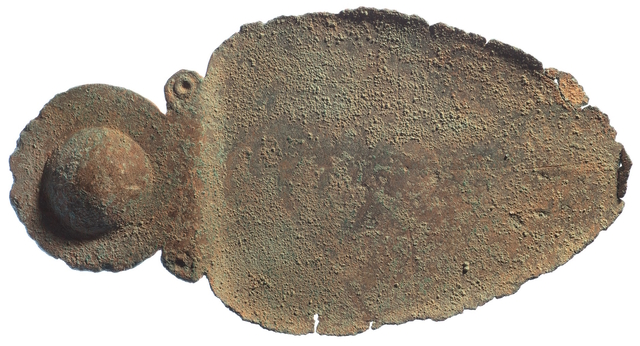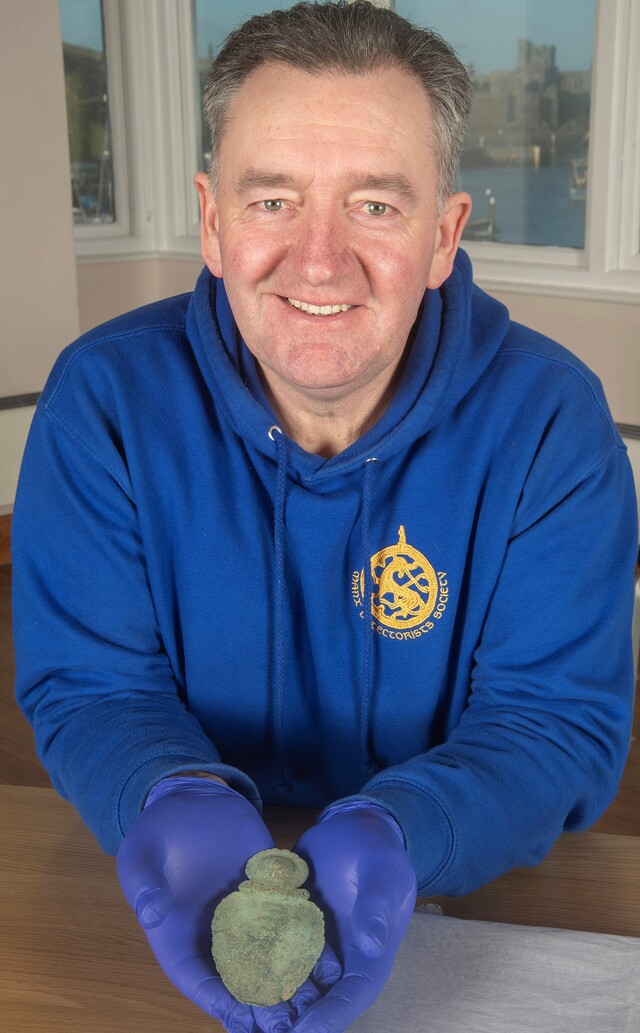The Isle of Man, a land steeped in history, has long been a subject of fascination for archaeologists and historians. Its strategic position between Great Britain and Ireland has made it a key player in numerous historical events, but it’s the quieter moments of its past that often yield the most intriguing discoveries. One such discovery was made recently when a rare Iron Age bronze spoon was unearthed on the Isle of Man. This 2,500-year-old object not only provides a glimpse into the daily life of the island’s early inhabitants but also offers a rare window into the spiritual and ritual practices that shaped their world.
The Discovery of the Spoon
In February 2025, metal detectorists Rob Middleton and Lisa Stephenson stumbled upon an astonishing find while scanning a field in the parish of Patrick, situated on the island’s west coast. The discovery was made on private land owned by farmer David Anderson, and as soon as Middleton and Stephenson uncovered the object, they realized they had found something far more significant than an ordinary relic. The spoon, broken in two parts, was soon pieced back together to reveal its striking design and detailed craftsmanship.
Upon reporting the discovery to the Treasure Trove Unit, the find was quickly assessed by experts from the Manx National Heritage, who were equally astounded by its rarity. The spoon, thought to date from 400-100 BC, is one of only 28 known examples worldwide. This find is the first of its kind ever discovered on the Isle of Man, further cementing the island’s importance in the broader context of ancient European history. Its significance lies not only in its age but also in its unusual purpose—likely serving as a tool for divination, a practice that offers valuable insight into the spiritual beliefs of Iron Age societies.
Video
Watch Iron Age Divination Spoon Discovered on the Isle of Man to explore this intriguing find from ancient history. A fascinating look into Iron Age rituals!
The Spoon’s Design and Features

The divination spoon is a remarkable artifact, both in its construction and its symbolism. Made of bronze, the spoon features a broad, strawberry-shaped bowl adorned with spiral patterns resembling tiny leaves. At the deepest part of the bowl, two engraved lines intersect in a cross, a design that has sparked considerable interest among researchers. The handle of the spoon is circular and crowned with a semi-spherical bump, suggesting the spoon was crafted with both functionality and aesthetics in mind.
The simplicity of the term “spoon” does little justice to the object’s profound cultural significance. While spoons were likely common in Iron Age households, the divination spoon is far from an ordinary kitchen utensil. Its ritualistic use sets it apart, making it one of the most intriguing finds of its kind. The fact that the spoon was found in the Isle of Man, a region where Iron Age artifacts are relatively scarce, makes this discovery even more exceptional.
The Divination Theory: How It Was Used
The most widely accepted theory surrounding the divination spoon is that it was used in a ritualistic practice designed to predict the future. Allison Fox, the Curator for Archaeology at Manx National Heritage, suggests that these spoons were often found in pairs and that liquid may have been poured into the spoon marked with the cross. The way the liquid settled in the bowl might have been interpreted as a sign, offering the user insight into the future or guiding them through difficult decisions.

While the exact nature of these divination rituals remains a mystery, the presence of similar spoons in other parts of Europe suggests that such practices were widespread. The engraved cross, a central feature of the spoon, could have been used to divide the bowl into sections, with each quadrant holding specific meaning depending on where the liquid landed. This theory aligns with other archaeological findings from the same period, where divination played a key role in the spiritual and social life of ancient communities.
The discovery of the spoon highlights the complex belief systems of Iron Age people, suggesting that they not only relied on physical tools but also sought to understand and control the forces of nature through ritual practices. In this way, the spoon serves as a direct link to the spiritual life of the island’s early inhabitants, shedding light on the rituals that might have been conducted in the secluded roundhouses and forts of the time.
Historical and Archaeological Context

The Iron Age in the British Isles, spanning from approximately 500 BC to 500 AD, was a period of significant social, political, and technological change. The Isle of Man, although not as widely studied as other parts of Europe, offers an interesting snapshot of this transitional phase. The island’s inhabitants lived in small, tightly-knit communities that relied on farming, fishing, and trade. The discovery of the divination spoon provides a rare glimpse into the spiritual practices of these people, who likely looked to the gods or spirits for guidance.
At this time, the island was home to small farming communities, who constructed roundhouses—wooden and stone buildings designed to withstand the harsh weather of the region. Strategic sites, such as South Barrule, were fortified, and evidence suggests that the Isle of Man had contact with neighboring cultures, including those in Roman Britain. Although there is no concrete evidence of Roman settlements on the island, artifacts from this period suggest that the people of the Isle of Man were well connected to the wider world.
This divination spoon adds another layer to the island’s archaeological record, offering evidence of the ways in which its inhabitants interpreted the world around them. It suggests that even in the Iron Age, the people of the Isle of Man were not isolated from the spiritual currents that swept through Europe, sharing common beliefs with neighboring regions while also developing their own unique practices.
The Importance of the Discovery
The find is significant not only because of its rarity but also because it expands our understanding of the spiritual and ritual practices of the Iron Age. Although the Isle of Man has yielded fewer Iron Age artifacts compared to other regions, the divination spoon provides an important piece of the puzzle. It is one of only a few objects of its kind, and its discovery on the island adds to the growing body of evidence about the island’s past.
The donation of the spoon to Manx National Heritage has made it possible for the public to learn more about the island’s ancient inhabitants. It is now on permanent display at the House of Manannan, a museum dedicated to the history and culture of the Isle of Man. This discovery also underscores the importance of collaboration between local landowners, archaeologists, and metal detectorists in uncovering the island’s rich history.
The Spoon’s Current and Future Role
Following its discovery, the spoon has been carefully preserved and is now part of the Manx National Collections. The object’s permanent display allows visitors to connect with the past, offering a tangible link to a time long gone. The spoon’s role as a divination tool opens up new avenues for research into Iron Age spirituality and divination practices, and its continued study will likely yield more insights into the cultural and religious beliefs of the island’s inhabitants.
The story of this remarkable find is not just about the object itself, but also about the ongoing exploration of the island’s rich history. The Isle of Man, though small in size, has played a significant role in the wider history of Europe, and discoveries like the divination spoon help illuminate this often-overlooked chapter of the island’s past.
Video
Watch 2,000-Year-Old ‘Future Telling’ Celtic Spoon Unearthed on Isle of Man to learn about this fascinating Celtic artifact. A must-see for history enthusiasts!
Conclusion: Unveiling the Past
The discovery of the 2,500-year-old divination spoon on the Isle of Man offers a fascinating glimpse into the ancient past. Far more than a simple utensil, this object represents the intersection of daily life, spiritual practice, and ritual in the Iron Age. Its unearthing is a reminder of the depth and complexity of the island’s history, and it contributes to the broader understanding of the Iron Age world. As the research into this find continues, we may uncover even more stories from the past, each one adding to the tapestry of life on the Isle of Man more than two millennia ago.



